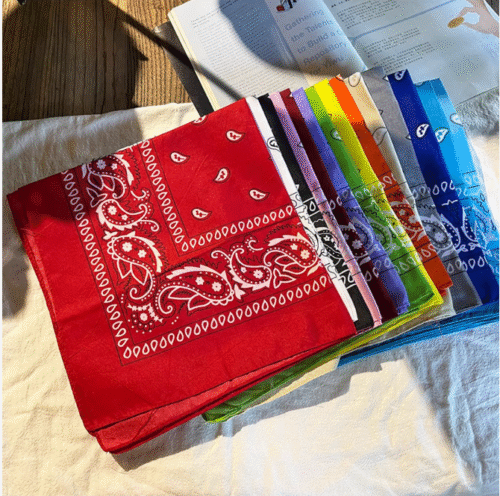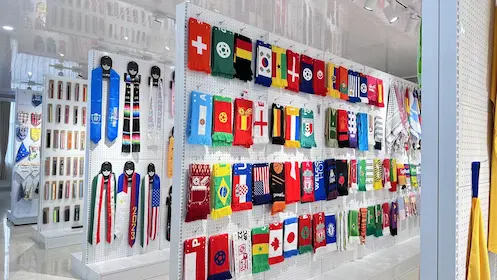Table of Contents
ToggleBeyond the Look: Why This Simple Square of Cloth Is the Ultimate Multi-Tool
1.Introduction: Redefining the Bandana — More Than Just a Piece of Cloth
Ask anyone what a bandana is, and you’ll hear different answers:
a fashion accessory, a headwrap, a sweatband, or a sign of identity.
But the real purpose of a bandana? Versatility.
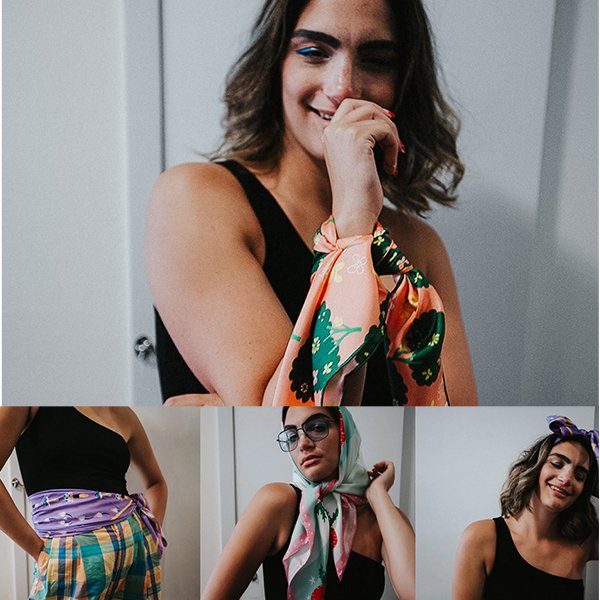
A bandana is a small piece of cloth that does big things. It adapts to whoever wears it — whether you’re working outdoors, hiking a trail, or dressing up for a night out.
The word bandana comes from the Hindi word bāndhnū, meaning “to tie or bind.” That origin perfectly captures its purpose — a tool designed to protect, connect, and transform.
(References: kamdana.com, sneum.com)
In this guide, we’ll explore how the bandana has stood the test of time by serving three core purposes:
- as a practical tool,
- a fashion statement, and
- a trusted emergency aid.
2.A Witness of History: How the Bandana Evolved
For centuries, the bandana has been both a symbol and a survival tool. Its long history proves one thing — good design never goes out of style.
From Workers to Cowboys
In the 19th century, American cowboys and ranch hands used cotton bandanas to shield their faces from dust and sun. Tied around the neck by day, pulled over the mouth when riding through dry trails, it was a cowboy’s version of modern-day protection gear.
(Source: coltercousa.com)
A Symbol of Identity
Through the 20th century, the bandana became a visual language of identity and belonging:
- Workers’ movements used red bandanas to show unity and strength.
- The LGBTQ+ community used the Hanky Code to express personal identity.
- In hip-hop and street culture, it became a bold statement of pride and roots.
(Reference: heddels.com)
From Icons to Runways
From Rosie the Riveter’s red polka-dot bandana — the face of empowerment — to high-fashion runways in Paris and Tokyo, this humble square of fabric continues to embody freedom, grit, and individual expression.
3.Core Purpose (1): The Bandana as a Utility Tool
If you love the outdoors, travel light, or just enjoy being prepared, a bandana might be the most useful item you can carry.
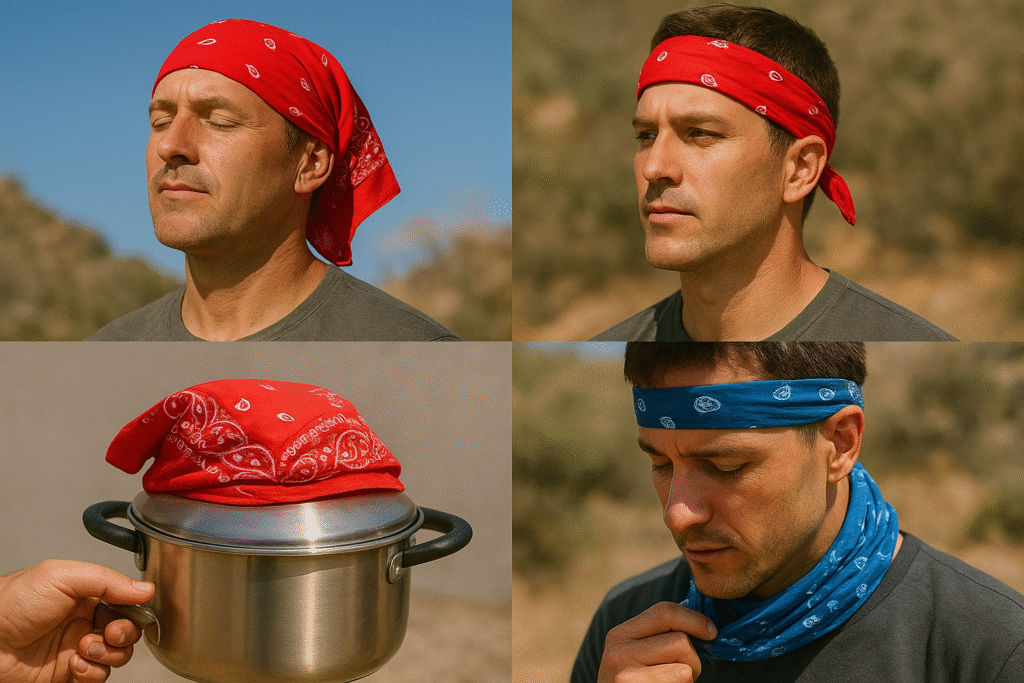
As Best Made Co. notes, “a good cotton bandana is the smallest, most versatile piece of gear you’ll ever own.”
Everyday Carry (EDC) Uses
- Protection from the elements:
Tie it around your neck to block the sun, or wear it as a headband to absorb sweat. - Face and dust cover:
A quick mask for cycling, mowing the lawn, or working in the wind. - Wipe and clean:
Works as a reusable handkerchief, napkin, or cloth for glasses and camera lenses. - Grip and insulation:
Fold it to handle a hot mug or twist off a tight bottle cap. - Binding and carrying:
Need a temporary tie or pouch? Fold your bandana into a small bindle to hold essentials.
Real-world example:
Imagine you’re hiking on a hot day — you soak your bandana in cool water and tie it around your neck. Instantly, your body temperature drops, and you feel the difference. Simple, effective, and free.
4.Core Purpose (2): The Bandana as a Fashion Statement
Style meets utility — that’s where the bandana shines.
As Christine Elder Studio explains, “the beauty of a bandana lies in its ability to blend casual comfort with timeless elegance.”

Headwear Styles
- Headband: Keeps sweat away and adds a sporty touch.
- Headwrap: A bohemian full-head cover for festivals or beach days.
- Hair tie: A soft, reusable way to tie up your hair with flair.
Neck and Body Accents
- Neckerchief: A nod to classic cowboy style or French chic.
- Pocket Square: Adds a pop of color to formal outfits.
- Wrist or ankle wrap: A subtle, expressive accessory.
Accessory Flair
Loop it through your bag strap, belt, or hat — a quick way to personalize your look without effort.
Expert tip:
- Choose silk bandanas for refined style.
- Opt for 100% cotton for an ideal balance between comfort, breathability, and durability.
5.Core Purpose (3): The Bandana as an Emergency Tool
In emergencies, that little square of cloth becomes surprisingly powerful.
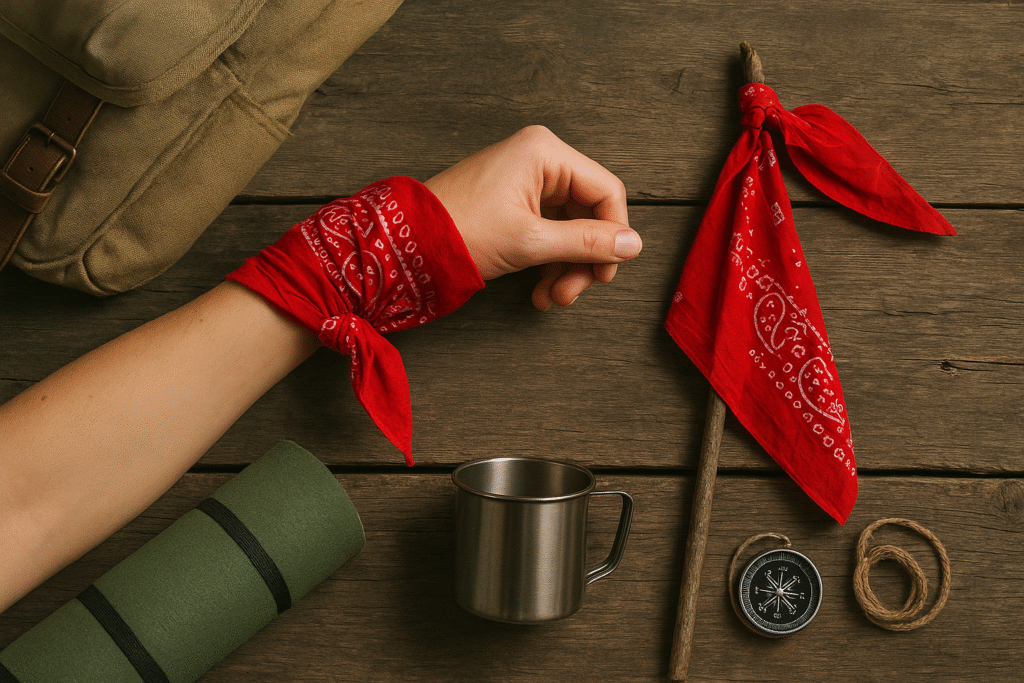
First Aid Applications
- Pressure bandage: Fold and apply to wounds to stop bleeding.
- Sling or splint tie: Support an injured arm or secure a brace.
- Tourniquet (only as last resort): Should be applied only by trained individuals when no alternatives exist.
(Source: coltercousa.com)
Survival and Signaling Uses
- Signal flag: Bright colors help rescuers spot you.
- Trail marker: Tear strips to mark your route.
- Water pre-filter: Strain out debris before purification.
- Fire starter: Dry cotton burns easily, making excellent tinder.
Whether camping, traveling, or in unexpected situations — a bandana proves that preparedness doesn’t need to be complicated.
6.How to Choose the Right Bandana
When you know your purpose, choosing the right one becomes easy.
Material Guide
- 100% Cotton: The all-rounder. Absorbent, soft, and durable — perfect for daily and emergency use.
- Silk: Luxurious and lightweight — best for fashion.
- Polyester or synthetics: Quick-drying and sweat-wicking — great for sports or outdoor activity.

Size and Edge Finish
- Standard size (22″ x 22″) is the most practical for folding, tying, or wearing.
- Stitched or hemmed edges are more durable and resist fraying over time.
7.Conclusion: The True Purpose of a Bandana — Defined by You
The purpose of a bandana isn’t fixed.
It’s what you make of it — a simple, durable square that adapts to your lifestyle.
From cowboys to climbers, artists to adventurers, this timeless piece has earned its place in pockets and backpacks across generations.
Because sometimes, the best tools aren’t the most complex —
they’re the ones that do everything, everywhere, and for everyone.
So next time you leave home, take a bandana with you.
You’ll be surprised how often that small square of cloth becomes exactly what you need.




